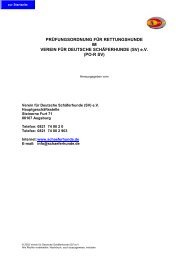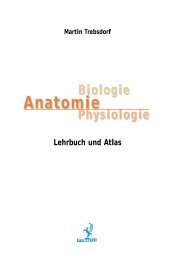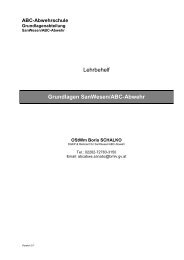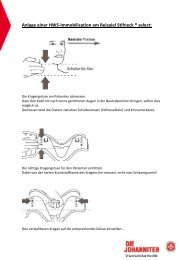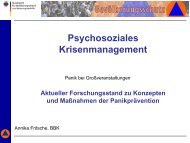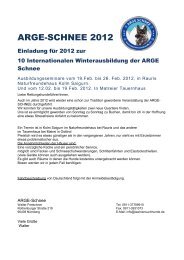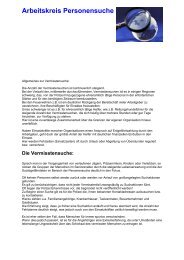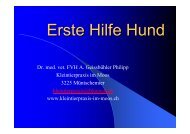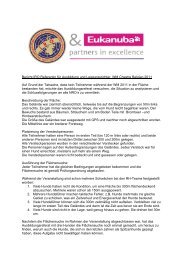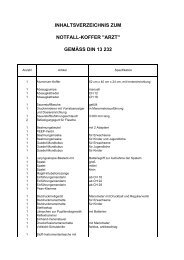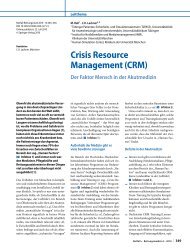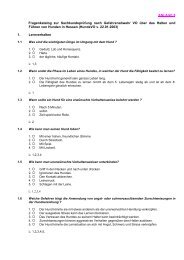DOG ASSESSMENT STANDARDS - Sardog
DOG ASSESSMENT STANDARDS - Sardog
DOG ASSESSMENT STANDARDS - Sardog
You also want an ePaper? Increase the reach of your titles
YUMPU automatically turns print PDFs into web optimized ePapers that Google loves.
<strong>DOG</strong> <strong>ASSESSMENT</strong> <strong>STANDARDS</strong><br />
Assessment standards shall be those set by the UK Fire Service USAR Dog Team, these standards,<br />
may where required be upgraded, altered, or added to.<br />
PREREGUISITES FOR <strong>DOG</strong><br />
Before grading the dog must meet the standards set out below.<br />
• Be fully vaccinated annually for the UK<br />
• Rabies vaccination for overseas teams (not a requirement for ND dog teams)<br />
• Regular treatment for parasites/worms<br />
• Be Micro-chipped for identification purposes<br />
• Qualify for the Pet Travel Scheme (overseas) (not a requirement for ND dog teams)<br />
• Insured via their individual brigade / group scheme<br />
• Hold membership of the UK Fire Service USAR Dog Team<br />
<strong>DOG</strong> GRADING <strong>STANDARDS</strong><br />
LEVEL ONE (Development)<br />
• A dog / handler who will be under the supervision of a trainer / mentor who will be working<br />
towards an operational grading.<br />
LEVEL TWO (Competent) Operational dog team.<br />
• However, in order to gain experience whilst guaranteeing best practice on the incident ground,<br />
it is recommended that these teams work in conjunction with an experienced team for the first<br />
12 months after their grading process.<br />
LEVEL THREE (Competent) International deployments.<br />
• The handler has met all the required competencies for overseas deployments. Not a<br />
requirement for ND dog teams<br />
The dog’s logbook will illustrate the theoretical and practical aspects that need to be achieved for each<br />
grading level. These areas must be signed off before practical grading can take place.<br />
GRADING, CERTIFICATION<br />
Initial grading for Level 2 and International deployments (Level 3)<br />
• To be deemed competent the dog and handler have to achieve competency in all modules of<br />
these standards.<br />
• The areas used for the assessments will be predetermined and assessors selected via the USAR<br />
dog team and communicated to dog teams a minimum of one calendar month before the<br />
assessment day.<br />
• All course criteria must be completed by the handler and signed off, before any dog team can<br />
be put forward for the grading. All handlers will need to demonstrate by means of their logbook<br />
that all relevant course criteria has been completed and signed off, by means of a competent<br />
person.<br />
Chris Pritchard UK Fire Service USAR Dog Team © - 1 - Version 8.0b
RE- EVALUATION OF <strong>DOG</strong> TEAMS<br />
A UK Fire Service USAR dog team comprising of a handler and dog who have successfully<br />
demonstrated the practical performance skills for level 2 and international deployments (level 3)<br />
must:<br />
• Maintain operational certification, teams must attend a national training event at least once<br />
in every 3 months to demonstrate continued operational competency. Training<br />
events will be held at least once every month.<br />
• Under the role of an USAR dog team (certificated team) all competency levels must be<br />
demonstrated and evaluated within every 12 month period to maintain operational<br />
certification.<br />
• These training sessions are aimed to identify individual teams training needs and to reevaluation<br />
the operational readiness of each team on a continued basis. A training plan will<br />
be discussed and agreed for each team attending these sessions. If the training need is of a<br />
competency issue or is safety critical, teams may be removed from the operational register<br />
until competency can be demonstrated.<br />
• These competences will consist of a minimum of the following:<br />
! 4 searches per year, collapsed structure searches.<br />
! 2 searches per year, building searches.<br />
! 2 searches per year, immediate area searches.<br />
! Obedience, demonstrated twice yearly.<br />
! Agility, demonstrated twice yearly.<br />
• These searches must consist of a mixture of day and night searches.<br />
• This will also include any theoretical work that encompasses USAR SAR Dog work.<br />
• This will be signed off in each of the handlers training logbooks by a competent person.<br />
• If these sessions are not attended, teams will be removed from the operational register<br />
until competency levels have been demonstrated at the next available training session.<br />
GRADING PANELS<br />
Level two Operational dog team<br />
• Each prospective trainee dog team will be assessed by their trainer/mentor when deemed<br />
ready for grading to level two.<br />
• A assessment / grading panel will be made up of the following personnel:<br />
! Two UK Fire Service USAR dog team assessors.<br />
! One assessor from a professional outside agency (home office accredited, Police<br />
Dog Handler / Trainer), (NUSARDG)<br />
Level three International deployments<br />
• The handler has demonstrated competency in the areas required for overseas deployments.<br />
Assessment dates<br />
• These will take place as and when needed, depending on the availability of dog teams requiring<br />
grading.<br />
Chris Pritchard UK Fire Service USAR Dog Team © - 2 - Version 8.0b
Scoring system<br />
• The scoring system for the practical assessments will be Competent or Not Yet Competent<br />
for each exercise of the module. If competency is not demonstrated the assessors will issue<br />
the handler with a written documented plan to assist the team to improve in these areas.<br />
IDENTIFICATION OF <strong>DOG</strong>S<br />
• All Fire Service USAR dogs must wear the issued colour coded identification dog disc on their<br />
collar when in a public place.<br />
• At all other times when working:<br />
! A high visibility harness must be worn for collapsed structural searches.<br />
Unless deemed unsafe by a dynamic risk assessment carried out by the<br />
handler.<br />
! For immediate area a high visibility harness or Fire Service Search & Rescue<br />
dog jacket must be worn to identify the dog.<br />
Colour coding of dog discs<br />
• Green – Trainee USAR Dog<br />
• Yellow – Operational USAR Dog<br />
Front of disc: Fire Service SAR Dog<br />
Back: Name of dog and 24 hr emergency contact number (Local FRS control<br />
number)<br />
• Red – Operational USAR and International Deployment Dog<br />
Front of disc: UK Fire Service SAR Dog<br />
Back: Name of dog and 24 hr emergency contact number 0044 + (Local FRS control<br />
number)<br />
COURSE CRITERIA<br />
• All handler qualifications relating to USAR dog work will be set collectively by USAR dog<br />
team.<br />
LEVEL TWO OPERATIONAL <strong>DOG</strong> TEAM<br />
• Minimum age of dog must be 12 months.<br />
• Pass 2 x six monthly review processes with a competent handler / trainer.<br />
• Successfully pass a practical dog assessment to level two.<br />
• Verbal questioning may be used to support the underpinning knowledge in the following<br />
areas.<br />
- Health and Safety<br />
- Environment and socialisation training<br />
- Obedience<br />
- Open area searches for urban/rural areas<br />
- Collapsed structure search<br />
- Building search<br />
- Protocols for working within the inner cordon<br />
- Operational handling skills and how teams are deployed<br />
- Working in temperate and hot climates<br />
- Understanding the stages of training for USAR dog<br />
- Capabilities and limitations<br />
- Dog training issues for both handler and dogs<br />
- Maintaining training logs<br />
Chris Pritchard UK Fire Service USAR Dog Team © - 3 - Version 8.0b
- Training of dogs to basic and advanced obedience<br />
- Transportation of dogs<br />
- Basic dog handling safety precautions<br />
- Safe systems of work for operational deployment<br />
- Understanding of the scent picture (transportation of scent)<br />
- Understand the principles and stages of training search dogs<br />
- Agility training<br />
- Understand the Kennel Club good citizen system<br />
- Risk Assessments<br />
- Rope work (access & egress)<br />
- Search management<br />
- Forensic evidence procedure<br />
- Continuation training<br />
- Factors affecting searches<br />
- Environmental training<br />
- Types of searches<br />
- Degrees of difficulty in search areas<br />
- Selection of training areas<br />
- Variety in training areas<br />
- Indication training<br />
- Loss to the dog’s standard of efficiency<br />
- Understand and use of Fire Service SAR Dog training log books<br />
- Understanding of the factors affecting a search dog team (capabilities and limitations)<br />
- Incident Command System<br />
- Standards for dog personal protective equipment<br />
Understanding of animal husbandry and in particular:<br />
- Hygiene<br />
- Grooming and bathing<br />
- Feeding<br />
- Exercise<br />
- Kennel management (accommodation / kennel hygiene)<br />
Understanding of and being able to provide advice on canine first aid:<br />
- Veterinary inspection positions<br />
- Principles of canine first aid<br />
- Common ailments and injuries<br />
- The transmission of infectious diseases<br />
- Maintenance of health and safety in sub-tropical countries<br />
- Internal and external parasites<br />
- Guide to a healthy dog<br />
- Signs of injury<br />
- Taking the dogs vital signs<br />
- Methods of temperature taking<br />
- Administration of medicines<br />
- Diarrhoea / loose motions<br />
- Choking / airway management<br />
- Sprain’s<br />
- Strings<br />
- Coughs<br />
- Kennel sores<br />
- Pads<br />
- Vomiting<br />
- Infectious / contagious diseases<br />
Chris Pritchard UK Fire Service USAR Dog Team © - 4 - Version 8.0b
• Logbook<br />
The Logbook will illustrate competence in the following subjects by means of<br />
completed continuation training sheets.<br />
! Obedience<br />
! Night searches<br />
! Day searches<br />
! Working at height<br />
! Agility<br />
! Confined space training<br />
! Urban searches<br />
! Rural searches<br />
! Collapsed structure searches<br />
! Area Searches<br />
! Transportation of dogs<br />
! Working with distractions<br />
! Multiple causalities<br />
! Varying degrees of difficulty in hide locations<br />
Additional courses<br />
! USAR, or similar recognised course<br />
! Risk Assessment (awareness / course<br />
! Incident Command Structure<br />
! First aid / trauma course<br />
! Recognised Rope course, including abseiling / descending with dog<br />
! Helicopter/ aircraft dog transportation instruction<br />
! Radio communication procedures<br />
! Search Management course (desirable)<br />
INTERNATIONAL DEPLOYMENTS<br />
• All theoretical and practical aspects level two must be completed.<br />
• Verbal and logbook evidence may be used to show competence in the following areas.<br />
! Fluid management / dehydration for the dog<br />
! Shock<br />
! Wounds<br />
! Pressure points<br />
! Internal bleeding recognition<br />
! Fractures<br />
! Poisoning<br />
! Heatstroke<br />
! Eye injuries<br />
! Ear injuries<br />
! Animal bites<br />
! Snake bites<br />
! Constipation<br />
! Mouth problems<br />
! Skin problems<br />
! Abscesses<br />
! Anal glands irritation<br />
! Suturing<br />
! Antibiotics<br />
! Euthanasia<br />
! Stress relief<br />
! Working for extended search periods<br />
! Working around different distractions as illustrated in logbook<br />
Chris Pritchard UK Fire Service USAR Dog Team © - 5 - Version 8.0b
! Extremes in cold or hot weather, dust and smoke or strong unpleasant odours etc<br />
! Cadaver training<br />
! Working competently on recent collapsed structures (excessive disturbance)<br />
Additional courses<br />
! Basic Veterinary awareness course<br />
! Camp management skills (overseas)<br />
! Awareness training on deployment of SAR dog teams overseas<br />
DEPLOYMENT PROCEDURES FOR UK FIRE SERVICE USAR <strong>DOG</strong> TEAMS<br />
DEPLOYMENT<br />
• Under no circumstances must a Level one trainee dog be deployed to an<br />
operational search operation.<br />
• Only level two and three dog teams can be mobilised for search operations.<br />
• When an operational dog team/s are called out to a search, it is required that the next<br />
available dog team/s be notified immediately and put on standby for deployment. This<br />
procedure is continued until adequate dogs are available at the search site. Best practice will<br />
dictate that at least two dogs are required for any single incident in order to facilitate<br />
confirmation of a find.<br />
• An appointed USAR coordinator will manage the deployment and operational co-ordination<br />
of these teams.<br />
INTERNATIONAL DEPLOYMENT<br />
• Only level three dog teams can be deployed for overseas search work, these teams will be<br />
on standby on a rotational system, as agreed/approved by UKFSSART.<br />
LIST OF OPERATIONAL <strong>DOG</strong>S<br />
• A list of all UK Fire Service USAR dog teams will be distributed annually to the Fire Services,<br />
Police forces and government SAR organisations. These lists will be updated regularly by the<br />
national coordinator.<br />
SPONSORS / MEDIA<br />
All handlers and their dogs when ever possible give full support to our sponsors, Masterfoods<br />
(Pedigree)<br />
• Sponsors logo, clothing etc. should be displayed at<br />
every available opportunity when dog and handler<br />
teams are in public places or being deployed.<br />
• All media coverage, whether radio, television or<br />
newspaper, teams should endeavour to promote the<br />
team’s sponsors, through logos or words. Any major<br />
or controversial media release must be approved by<br />
the team external relations co-ordinator or user<br />
group.<br />
EQUIPMENT<br />
• Any equipment issued by the USAR dog team will always remain the property of the UK Fire<br />
Service USAR dog team if purchased via team sponsorship. Equipment must be cared for<br />
and kept in a clean state for immediate operational use. All equipment issued to a handler<br />
will be signed for upon receipt, and an equipment register will be maintained for audit<br />
purposes.<br />
Chris Pritchard UK Fire Service USAR Dog Team © - 6 - Version 8.0b
APPENDIX A<br />
OBEDIENCE PRACTICAL MODULE<br />
These exercises are designed to test the working relationship between dog and handler. The<br />
commands will focus on situations that the team will use on a daily basis to control, exercise and work<br />
the dog.<br />
The actual sequence of the exercises will be communicated on the day of the assessment.<br />
Timings: 10 minutes for individual obedience on / off lead. (Module A)<br />
15 minutes for group session on / off lead. (Module A)<br />
20 minutes for loose working obedience. (Module B)<br />
Any dog that shows aggression towards another dog or person may be disqualified from the<br />
assessment at any time. All assessors must agree on this decision before the team can be disqualified.<br />
BASIC OBEDIENCE (module A)<br />
• The exercise will contain obedience heel work on and off the lead incorporating:<br />
! Right and left turns<br />
! About turns<br />
! Halts<br />
! Recalls<br />
! Stays<br />
! Sit and down commands<br />
! Changes in pace (normal, fast and slow)<br />
! Long stay 5 minutes, handler 50 m away from dog. Handler can command the<br />
dog to stay at any time with hand and voice commands. Dog must not move<br />
more than a body length in any direction.<br />
• This test will be carried out individually and in a group session.<br />
• The dog must heel with its shoulder at knee level, to the left side of the handler.<br />
• Any undue lagging or distancing to the side or rear of the handler by the dog will be<br />
discouraged, as will undue corrections and pressure from the handler. In severe cases the<br />
assessment panel may fail the team.<br />
LOOSE WORKING OBEDIENCE (module B)<br />
In order for the team to carry out effective searches, the dog must demonstrate the ability to be<br />
directed and controlled by the handler via audible and/or either visual signal.<br />
• The actual test sequence will be communicated on the day of the assessment.<br />
• The dog will be off the lead under the direct control of their handler, unless stated by the<br />
assessors.<br />
• A predetermined course may be designed or incorporated into the search modules.<br />
• The assessors may ask for the following during the exercise: -<br />
! Directional control<br />
! To leave a desirable item that the dog may come across and return to handler<br />
! Heel work<br />
! Halting the dog at distance (drop recall)<br />
! Control and direct the dog around a situation (E.G. a stray dog)<br />
! Recalling the dog when asked<br />
! Drop recall<br />
Chris Pritchard UK Fire Service USAR Dog Team © - 7 - Version 8.0b
! Using additional words of command to get the dog to negotiate specific obstacles<br />
(E.G. Walls and other similar natural obstacles)<br />
! Examples: -<br />
! Up<br />
! Over<br />
! Through<br />
There are no restrictions on hand signals and voice commands that can be given to the dog during the<br />
exercise.<br />
SEARCH WORK PRACTICAL MODULES<br />
The handler will need to demonstrate the practical aspects regarding operational search procedures,<br />
including a theoretical question and answer session by the assessors.<br />
• Demonstrate a full understanding of the following: -<br />
• Safe Systems of Work for a USAR dog team.<br />
• Familiarisation of the area (search brief from assessor team).<br />
• Risk assessment of the area and take the appropriate measures needed.<br />
• Give a search brief to safety person.<br />
• Preparation of team for search.<br />
• Free search.<br />
• Systematic search.<br />
• Fingertip close search.<br />
• Perimeter search.<br />
• Rope access / safety line work.<br />
• Reporting points of interest or indications to safety person / assessors.<br />
• Demonstrate a full body check of their dog for any injuries that may have been sustained<br />
during the search.<br />
• The different types of search de-brief<br />
• Carry out personal administration to prepare the team for next search.<br />
Exercise timings<br />
• 20 - 30 minutes for COLLAPSED STRUCTURE SEARCH (Module A)<br />
• 15 minutes for INDOOR BUILDING SEARCH (Module B)<br />
• 1 hour for IMMEDIATE AREA SEARCH (Module C)<br />
Casualties<br />
• Individuals that are acting as trapped casualties or lost individuals will be in place at least 30<br />
minutes before an assessment commences.<br />
• Casualty locations and number of casualties will be decided on the day of the assessment by the<br />
grading panel for each of the modules. These will vary from 0 – 5 casualties per search and<br />
may include a blank search area with no causalities.<br />
Hide locations<br />
• Height / Depth of hides will vary according to conditions available on the day and should include<br />
a partially hidden casualty.<br />
• All casualties will be concealed from view in pre-constructed hides, conforming to the Health<br />
and Safety Work act 1974.<br />
• The hides should be constructed to prevent the dog from gaining direct access to the casualties.<br />
Risk Assessments<br />
• A generic risk assessment will take place before the day of the assessment.<br />
• A dynamic risk assessment will also be carried out on the day of the assessment.<br />
• Each team will also continue this risk assessment constantly during the exercise.<br />
Chris Pritchard UK Fire Service USAR Dog Team © - 8 - Version 8.0b
Disturbance / Distractions / Noise of the search area<br />
• All areas must be totally disturbed 1hr before any assessment takes place, by either a group of<br />
persons criss-crossing the area causing as much disturbance as possible or using plant<br />
machinery to cause the same affect.<br />
• To simulate the noise of a disaster environment the following equipment should be used: -<br />
! Running machinery (generators)<br />
! Rescue tools<br />
! Audio tapes can also be used to simulate the above<br />
• The collapsed structure searches must contain the following associated scents from a recently<br />
lived<br />
in dwelling:<br />
! Clothing<br />
! Furniture & other domestic appliances<br />
! Food items<br />
! Disturbance<br />
! Traces of recent human scent in area<br />
Additional scents / distractions<br />
! Cadaver scent<br />
! Live animals<br />
Working the dog<br />
• The handler may use a variety of verbal commands and hand signals to direct the dog<br />
throughout the search. This will include any specialist safety equipment that may be required<br />
for working at height or near an exposed edge.<br />
Indication<br />
Due to the variety of different types of searches carried out by the UK Fire Service USAR Dog Teams<br />
across the United Kingdom, there are two types of indications that are allowed to be used on the<br />
assessment.<br />
! The Bounce Back (refind)<br />
! The Stand Over<br />
!<br />
The assessors must be informed of the type of indication that the dog will give before the<br />
commencement of the search module assessments.<br />
• The dog’s indication must be positive by barking and staying in the direct vicinity of the<br />
casualty/s for a minimum of 30 seconds. The indication can also include as well as barking<br />
digging and attempts to reach the casualty/s. Once this time limit has expired the assessor will<br />
then inform the handler to continue with the search.<br />
• If the dog only shows interest in a specific area without giving the standard indication, the<br />
handler must inform the assessors immediately so this can be recorded. All assessors must<br />
agree by using their own experience that the dog has shown sufficient interest and can be<br />
credited with the find.<br />
• One false indication is allowed on each of the search modules. This will be down to the<br />
assessors to determine the source and the reason why the dog has given an indication.<br />
• Any handler that intentionally makes their dog false indicate with excessive verbal<br />
encouragement will fail the assessment.<br />
Dog toys<br />
• Toys can be used during the search modules, as reward for a positive indication. Approval must<br />
be sort from the assessment panel on each occasion.<br />
Chris Pritchard UK Fire Service USAR Dog Team © - 9 - Version 8.0b
SEARCH AREAS<br />
COLLASPED STRUCTURE SEARCH (Module A)<br />
• The size of the buildings will be approximately, 30 metres by 30 metres with multiple floor<br />
levels that will need to be accessed safely by the team. It should consist predominantly of<br />
concrete and bricks or a mixture of materials common to disaster sites.<br />
• Within a search area consisting of multiple buildings 200m x 200m minimum.<br />
• A minimum of 4 searches will be required incorporating day and night searches.<br />
INDOOR BUILDING SEARCH (Module B)<br />
• The search area will be made up of an area that has a minimum of two storeys containing no<br />
less than fifteen rooms. The building must also contain an area that has a darkened area / sub<br />
terrain, where the team can carry out a search under artificial light.<br />
• A minimum of 2 searches will be required at day and night.<br />
IMMEDIATE AREA SEARCH (Module C)<br />
• An open area approximately 1000m by 1000m containing a typical cross section of urban and<br />
rural areas.<br />
• A minimum of 2 searches will be required at day and night.<br />
• All these searches will be carried out over a minimum of a 36hr period.<br />
• Multiple casualties from 0 -5 will be placed on each search.<br />
• 1 miss of a casualty will be allowed during the grading process.<br />
• 2 mistakes are allowed by the handler during this process. See additional<br />
documentation.<br />
AGILITY PRACTICAL MODULE<br />
This will be incorporated into all the practical search scenarios.<br />
• The exercises will be of a design to simulate actual obstacles that may be encountered on an<br />
operational task and specific actions that will need to be carried out by the team whilst being<br />
operational.<br />
• The handler can use as many different verbal commands and hand signals to direct the dog.<br />
• The dog will work off the lead (loose) under the direct control of their handler.<br />
The assessors will be looking for:<br />
• Handlers and dogs working as a team<br />
• The dogs negotiating different types of surfaces, materials and other obstacles with confidence.<br />
! Slippery surfaces<br />
! Piles of unstable materials<br />
! Dense vegetation<br />
! Working at height<br />
! Confined space entry / egress<br />
• If the dog shows signs of excessive stress during these exercises, the assessors may stop the<br />
process at any time if this is the case.<br />
Pre – grading course work<br />
These exercises need to be carried out with competent personnel and signed off in their log book<br />
before the grading process.<br />
• Appropriate protective safety equipment will be available for these exercises.<br />
! ladder climb and working at height in conjunction with working at height equipment<br />
! Being transported via a Mobile Platform<br />
Chris Pritchard UK Fire Service USAR Dog Team © - 10 - Version 8.0b



